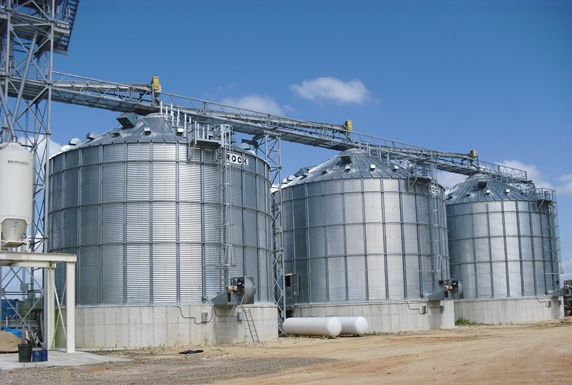For many, Belize is a place to rest and relax. It’s a small country, and a place where cultures and languages mix. It’s also a place where beans and rice are food staples, which explains why a new facility was being built and why a crew came down not for vacation but to apply spray polyurethane foam (SPF) and coatings on seven bean-holding bins.
“The whole project down there is very interesting. The reason they are building the facility is to give the country of Belize another source to buy beans,” said Jenny Bulfer, co-owner of contracting firm Greener World Solutions. In total, they covered about 2,100 linear feet (640.1 m) with SPF.
Not for the Birds
For the Minnesota-based crew, it wasn’t just the four-person team that had to trek to the remote jobsite; it was a journey for the equipment and materials, too. Because Belize didn’t have a store for the crew to run to if they were missing any equipment, materials, or replacement parts, Greener World Co-Owner Dan Bulfer prepared the shipment to spec — and then some. “There’s no Graco equipment store probably anywhere in Belize, so if we had an equipment failure and didn’t have the part, we’d be stuck there,” Jenny said. On this project, that meant shipping off the equipment to the Central American site for the client, which wishes to remain unnamed.
“We were very lucky from the standpoint that they already had shipping containers moving back and forth from this project to Minnesota,” Dan explained. “So we loaded our products and our machine onto one of their containers and then they took it to the Gulf, loaded it onto a ship, the ship took it to Belize and delivered to the jobsite.”
It took little time for the crew to arrive on site. They stayed in a 1950’s art deco-style hotel about 20 minutes away. For everything else, though, the journey took three weeks. And once compiled on site, you’d think the crew would have been able to get to work right away. The weather had other ideas, though.
“Some of the biggest challenges were with the environment,” said Dan. “We had an absolute fog until 11 to 12 o’clock every day when we couldn’t even operate. The fog was so dense that you couldn’t see 30 to 40 feet [9.1‒12.2 m] in front of you. And all of that moisture prevented us from doing anything but pressure washing.”
Belize, home to jungle and coast, is humid. This was no surprise to the Greener World crew. After all, it’s that humidity that was creating problems for both the bins and the beans within them, and the need for the SPF system in the first place. “There was so much moisture there that the seals were already leaking and deteriorating because of all of the [dampness],” said Jenny.
Once they were able to get past the power washing phase, completed with a gas-powered Honda, they got to the coated SPF system. The crew spray applied a 3-inch (7.6 cm) lift of closed-cell SPF, also called spray foam, using a Graco E30 Reactor. Wearing stilts to reach the shorter heights, the crew applied Covestro’s Bayblock CCX, a two-pound (907.2 g) spray foam, around the bottom edge and on the top vents. “With the large annual rainfall and the humidity at the site, they are producing edible beans that could not withstand moisture and they needed to seal up the bins to keep the moisture away from the beans,” Dan said.

“We applied the spray foam in kind of a half-moon shape, so there wasn’t an L-shaped gap at the base and any moisture would wick away from the bottom of the bin,” Jenny explained. The bottom bases were concrete and the sides were steel.
On top of the spray foam, the crew spray applied two layers of acrylic elastomeric, Covestro’s Bayseal, to achieve an average of 32 mils (812.8 microns). That was sprayed with a Graco 833, and into the second layer, the crew broadcast 3M roofing granules to “cover” the coating, according to Dan. This helped “to strengthen the end product and to deter birds,” Jenny said. “We found that that helped keep the birds off of it.”
Birds’-Eye View
Because the project took place outside the United States, the four people who comprised the crew were all co-owners of Greener World (in addition to Jenny and Dan, the other two owners are Philip Bulfer and Amber Bulfer). “Once you set foot off of American soil, you aren’t under American workers’ comp anymore,” Jenny explained. “But as owners, we can be covered under our own health insurance.” The success of the project was up to the bosses on this one!
Safety was up to them, too. Throughout the project, the crew wore coveralls, 3M masks, and goggles. And while working on the top of the bins, they were sure to wear safety harnesses.
Getting to see this project come to completion, especially as it was in a developing country, was one of the main takeaways for this crew. According to Jenny, the country wanted to create competition to bring the cost of food down for Belizeans. Within eight days, the Greener World crew helped them do just that. “It was pretty neat to see that — how they went out into the jungle and started building this huge commercial farm,” she said. “It’s pretty amazing.”
